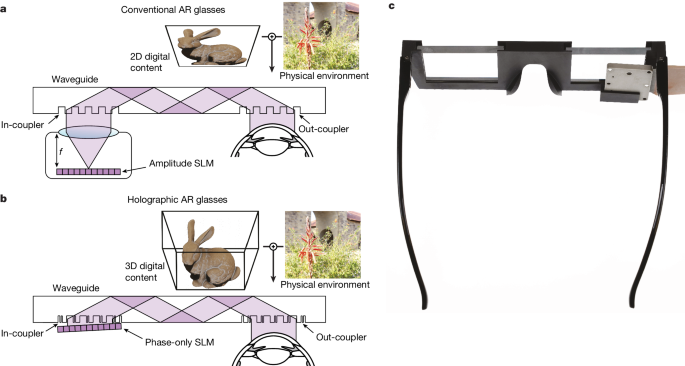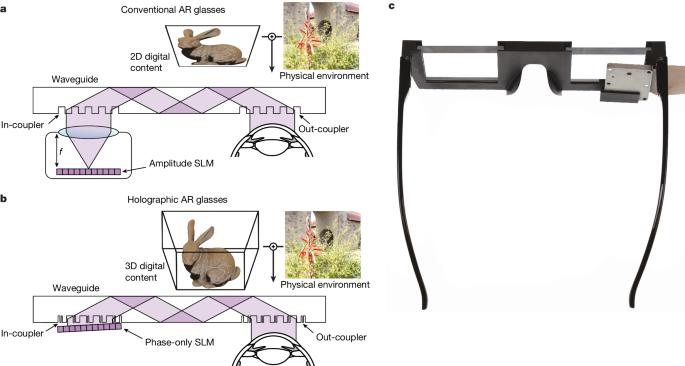Full-colour 3D holographic augmented-reality displays with metasurface waveguides
IF 48.5
1区 综合性期刊
Q1 MULTIDISCIPLINARY SCIENCES
引用次数: 0
Abstract
Emerging spatial computing systems seamlessly superimpose digital information on the physical environment observed by a user, enabling transformative experiences across various domains, such as entertainment, education, communication and training1–3. However, the widespread adoption of augmented-reality (AR) displays has been limited due to the bulky projection optics of their light engines and their inability to accurately portray three-dimensional (3D) depth cues for virtual content, among other factors4,5. Here we introduce a holographic AR system that overcomes these challenges using a unique combination of inverse-designed full-colour metasurface gratings, a compact dispersion-compensating waveguide geometry and artificial-intelligence-driven holography algorithms. These elements are co-designed to eliminate the need for bulky collimation optics between the spatial light modulator and the waveguide and to present vibrant, full-colour, 3D AR content in a compact device form factor. To deliver unprecedented visual quality with our prototype, we develop an innovative image formation model that combines a physically accurate waveguide model with learned components that are automatically calibrated using camera feedback. Our unique co-design of a nanophotonic metasurface waveguide and artificial-intelligence-driven holographic algorithms represents a significant advancement in creating visually compelling 3D AR experiences in a compact wearable device. We develop a method for providing high-quality, holographic, three-dimensional augmented-reality images in a small form factor suitable for incorporation in eyeglass-scale wearables, using high-refraction-index glass waveguides with nanoscale metasurfaces, and incorporating artificial intelligence.


使用超表面波导的全彩 3D 全息增强现实显示器。
新兴的空间计算系统可将数字信息无缝叠加到用户观察到的物理环境上,从而在娱乐、教育、通信和培训等各个领域实现变革性体验1-3。然而,由于增强现实(AR)显示器的光引擎采用了笨重的投影光学系统,且无法准确描绘虚拟内容的三维(3D)深度线索等因素,其广泛应用受到了限制4,5。在此,我们介绍一种全息 AR 系统,该系统采用独特的反向设计全彩超表面光栅、紧凑型色散补偿波导几何结构和人工智能驱动的全息算法组合,克服了上述挑战。这些元素的共同设计使空间光调制器和波导之间不再需要笨重的准直光学器件,并以紧凑的设备外形呈现生动的全彩 3D AR 内容。为了利用我们的原型提供前所未有的视觉质量,我们开发了一种创新的图像形成模型,该模型将物理上精确的波导模型与利用相机反馈自动校准的学习组件相结合。我们对纳米光子元表面波导和人工智能驱动的全息算法进行了独特的联合设计,这代表了在紧凑型可穿戴设备中创建具有视觉吸引力的 3D AR 体验方面取得的重大进展。
本文章由计算机程序翻译,如有差异,请以英文原文为准。
求助全文
约1分钟内获得全文
求助全文
来源期刊

Nature
综合性期刊-综合性期刊
CiteScore
90.00
自引率
1.20%
发文量
3652
审稿时长
3 months
期刊介绍:
Nature is a prestigious international journal that publishes peer-reviewed research in various scientific and technological fields. The selection of articles is based on criteria such as originality, importance, interdisciplinary relevance, timeliness, accessibility, elegance, and surprising conclusions. In addition to showcasing significant scientific advances, Nature delivers rapid, authoritative, insightful news, and interpretation of current and upcoming trends impacting science, scientists, and the broader public. The journal serves a dual purpose: firstly, to promptly share noteworthy scientific advances and foster discussions among scientists, and secondly, to ensure the swift dissemination of scientific results globally, emphasizing their significance for knowledge, culture, and daily life.
 求助内容:
求助内容: 应助结果提醒方式:
应助结果提醒方式:


